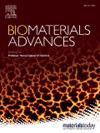神经创伤治疗的bigels综述:组织微环境对齐的结构见解
IF 6
2区 医学
Q2 MATERIALS SCIENCE, BIOMATERIALS
Materials Science & Engineering C-Materials for Biological Applications
Pub Date : 2025-04-09
DOI:10.1016/j.bioadv.2025.214315
引用次数: 0
摘要
由于大脑有限的再生能力和开发能够提供机械支持和局部治疗递送的生物材料的复杂性,神经损伤构成了一个重大的临床挑战。传统的生物材料如水凝胶和电纺丝支架具有局限性,包括不理想的机械完整性和不受控制的药物扩散。Bigels是由亲水相和疏水相组成的双相系统,具有可调的粘弹性、增强的载药能力和结构适应性,是解决神经治疗应用多方面需求的有希望的候选者。尽管它们在透皮应用方面已经有了应用,但bigels在神经治疗方面的潜力仍未得到充分的探索。这篇综述严格审查了bigel配方策略,物理化学特性和神经再生潜力。关键的分析技术,包括振荡流变学,扫描电子显微镜,傅里叶变换红外光谱,探索评估孔隙形态,粘弹性行为和分子相互作用。强调了bigels在神经元存活、轴突再生和神经炎症调节中的作用,以及可扩展性、批间可重复性和良好生产规范(GMP)下的法规依从性。未来的研究应侧重于优化生物降解动力学,神经营养因子释放谱,以及创伤性脑损伤和脊髓损伤模型的临床前验证。bigel技术的发展有助于其作为神经保护支架在再生医学中的临床转化。本文章由计算机程序翻译,如有差异,请以英文原文为准。
A review of bigels for neurotrauma therapeutics: Structural insights for tissue microenvironment alignment
Neural injuries pose a significant clinical challenge due to the brain's limited regenerative capacity and the complexity of developing biomaterials that can provide mechanical support and localized therapeutic delivery. Conventional biomaterials such as hydrogels and electrospun scaffolds exhibit limitations, including suboptimal mechanical integrity and uncontrolled drug diffusion. Bigels, biphasic systems composed of interpenetrating hydrophilic and hydrophobic phases, offer tunable viscoelasticity, enhanced drug loading capacity, and structural adaptability, making them promising candidates for addressing the multifaceted requirements of neurotherapeutics applications. Despite their established applications in the transdermal application, the potential of bigels in neurotherapeutics remains underexplored. This review critically examines bigel formulation strategies, physicochemical characteristics, and neuroregenerative potential. Key analytical techniques, including oscillatory rheology, scanning electron microscopy, and Fourier-transform infrared spectroscopy, are explored to assess pore morphology, viscoelastic behavior, and molecular interactions. The role of bigels in neuronal survival, axonal regeneration, and neuroinflammation modulation is highlighted, alongside considerations for scalability, batch-to-batch reproducibility, and regulatory compliance under Good Manufacturing Practices (GMP). Future research should focus on optimizing biodegradation kinetics, neurotrophic factor release profiles, and preclinical validation in traumatic brain injury and spinal cord injury models. Advancing bigel technology could facilitate their clinical translation as neuroprotective scaffolds in regenerative medicine.
求助全文
通过发布文献求助,成功后即可免费获取论文全文。
去求助
来源期刊
CiteScore
17.80
自引率
0.00%
发文量
501
审稿时长
27 days
期刊介绍:
Biomaterials Advances, previously known as Materials Science and Engineering: C-Materials for Biological Applications (P-ISSN: 0928-4931, E-ISSN: 1873-0191). Includes topics at the interface of the biomedical sciences and materials engineering. These topics include:
• Bioinspired and biomimetic materials for medical applications
• Materials of biological origin for medical applications
• Materials for "active" medical applications
• Self-assembling and self-healing materials for medical applications
• "Smart" (i.e., stimulus-response) materials for medical applications
• Ceramic, metallic, polymeric, and composite materials for medical applications
• Materials for in vivo sensing
• Materials for in vivo imaging
• Materials for delivery of pharmacologic agents and vaccines
• Novel approaches for characterizing and modeling materials for medical applications
Manuscripts on biological topics without a materials science component, or manuscripts on materials science without biological applications, will not be considered for publication in Materials Science and Engineering C. New submissions are first assessed for language, scope and originality (plagiarism check) and can be desk rejected before review if they need English language improvements, are out of scope or present excessive duplication with published sources.
Biomaterials Advances sits within Elsevier''s biomaterials science portfolio alongside Biomaterials, Materials Today Bio and Biomaterials and Biosystems. As part of the broader Materials Today family, Biomaterials Advances offers authors rigorous peer review, rapid decisions, and high visibility. We look forward to receiving your submissions!

 求助内容:
求助内容: 应助结果提醒方式:
应助结果提醒方式:


